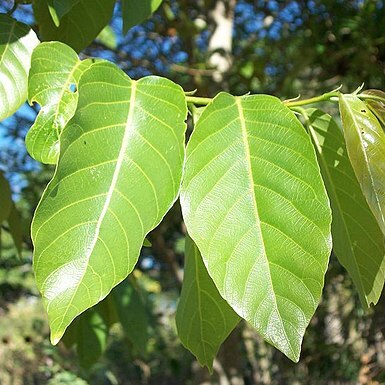Male flowers: pedicels 1.5–2 mm, apically dilated, minutely puberulous; sepals 2.5 × 1.3 mm, elliptic-lanceolate, acute, pubescent without, glabrous within, pale green or yellowish-green; petals 2 × 1.2 mm, obovate, slightly erose at apex, glabrous, yellowish; disk 2.5 mm in diameter, annular, flat; staminal column 1.5 mm high, free part of filaments 0.5 mm long, tapering to apex; anthers 0.8 mm long, glabrous; pistillode (non-functional ovary) 1 mm high, conical, verruculose.
Leaf blades 3–15 × 2–9 cm, broadly elliptic to suborbicular-obovate, obtuse to emarginate, rarely subacute, rounded to shallowly cordulate at the base, firmly chartaceous, softly and usually densely pubescent or almost tomentose above and beneath, light green; lateral nerves in 10–15(20) pairs, closely parallel, arcuate, sometimes reaching the margin or looping, occasionally branched, not prominent above, slightly so beneath, tertiary nerves parallel.
Female flowers subsessile; sepals 2.5–3 × 1.5 mm, triangular-lanceolate, otherwise as in the male; petals 2 × 0.75 mm, oblong-lanceolate, subentire; outer disk 2 mm in diameter, glabrous; inner disk c. 2 mm high, conical, tunicate, apically lacerate; ovary 1 mm in diameter, glabrous; styles 1.5 mm long.
Shrub or small tree, up to 7 m high. Leaves ovate to obovate, 25-130 x 13-90 mm, apex broadly tapering and often notched, both leaf surfaces with dense velvety hairs, lateral veins terminating in margin. Flowers greenish yellow.
Fruits 0.9–1.1 × 0.7–1 cm when dried, ellipsoid-subglobose, 2-celled, dark brown, black or blue-black when mature, exuding a gummy resin.
Stipules 5–10 × 2–4 mm, falcate-lanceolate, acutely acuminate, densely pubescent, subpersistent.
A shrub or small tree up to 9 m in height, branching close to the ground.
Twigs, young shoots and petioles evenly to densely fulvous-tomentose.
Seeds c. 7 × 5 × 3 mm, plano-convex, smooth, shiny, chestnut-brown.
Bark thick, rough, striated, flaky, dark brownish-grey.
Petioles 3–5 mm long.


